HP Envy 17: HP's MacBook Pro Killer?
by Dustin Sklavos on December 16, 2010 12:30 AM ESTThe 1080p BrightView Infinity LED EX plus Alpha
If nothing else, we'd appreciate it if HP cut down the number of words used to describe their screen, but that said, we're always big fans of seeing at least 1080p screens around here. This resolution feels like it should pretty much be the standard from about 15.6" upward (at least, given the quality of the screens we've seen at that size and resolution), and the Envy 17's screen is at least subjectively of good quality. Now let's see how it measures out.
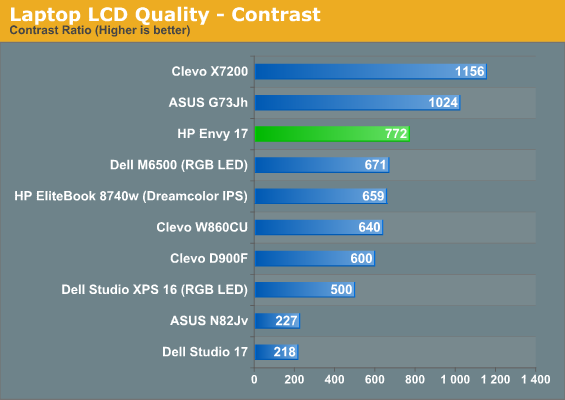
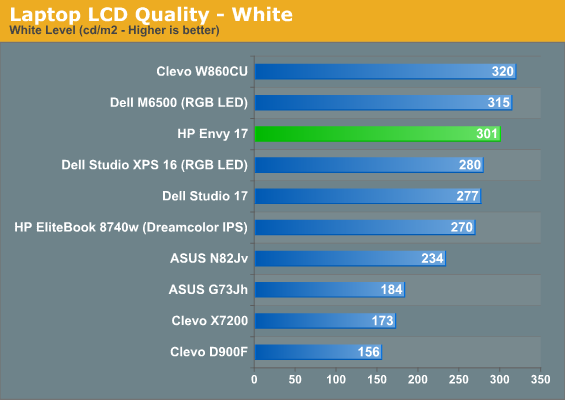

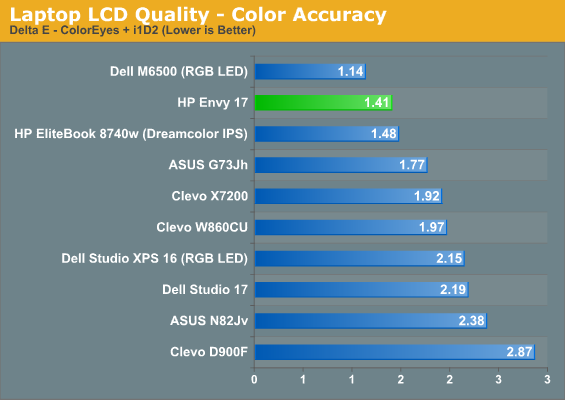
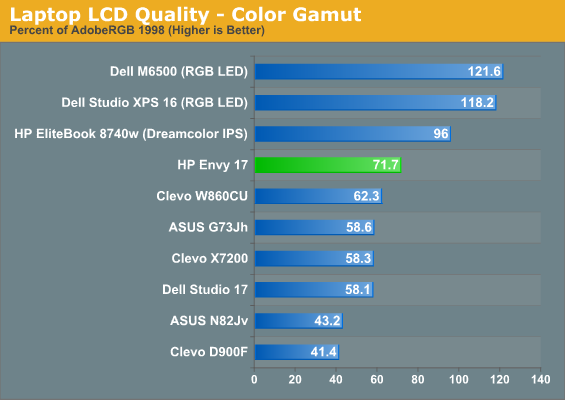
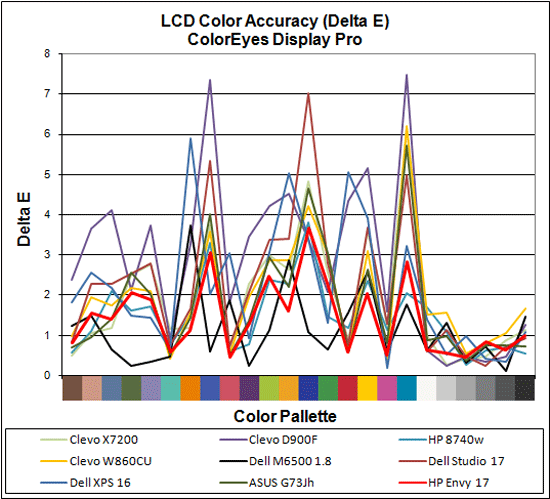

If nothing else, the screen HP employs on the Envy 17 is among the best we've seen. The upgrade from the 900p to 1080p screen when customizing the notebook is just $100 and we think that's absolutely worth it. HP advertises a 72% color gamut and we practically hit that on the dot. (Note: 68% of AdobeRGB is where sRGB falls, so in practice the 72% value is far better than the oversaturated result you get with high-gamut displays in non-color-managed applications.) Contrast, levels, and color accuracy are all excellent and at least in subjective use the screen is attractive. Viewing angles aren't a major issue either; the Envy 17's screen doesn't have a massive "sweet spot" problem the way many smaller or lesser quality screens do.
See, this is what we're talking about when we say we want to see better screens in notebooks. Now we just wish we could get these kinds of panels without having to constantly buy premium-grade hardware.










85 Comments
View All Comments
MobiusStrip - Sunday, December 19, 2010 - link
People need to reject these asinine glossy screens. This is cheap crap inspired by the low-grade, fake-chromed, Celeron-packing lineup at Best Buy, Manufacturers embarrass themselves by pushing this out as anywhere near a high-end offering, and they offend consumers by lying about its merits."Richer" colors? "Deeper" blacks? NO, because your entire display is covered with a sheen of reflection 100 percent of the time. Even in a pitch-black room, the computer lights YOU up and thus you're staring at yourself instead of what you're working on.
Demand better, people. Glossy screens are the biggest regression in computing... possibly ever.
freespace303 - Tuesday, December 21, 2010 - link
I've been using a 13" MacBook Pro since June, and I have to disagree with you sir. The glossy screen doesn't bother me at all. I would have to have a plain black background to catch a glimpse of me in the reflection, or be in a very bright room. As I'm typing this reply on this very laptop, in a dark room, I don't see myself, or any other reflections. It's quite nice.Now, on the other hand, if your using a laptop outside ALL THE TIME, during the day, then yes, I would probably go for a matte screen, but for my needs, and considering I use it most of the time, that isn't the case.
Also, the 13" MBP does have one of the brightest and nicest screens for a laptop this size. That's probably why I don't see glossy screens as much of a problem.
Oh, and I'm not Apple biased at all, considering I just ordered myself the HP Envy 17 3D!
freespace303 - Sunday, December 19, 2010 - link
OMG thankyou, I've been waiting for this review for SO LONG!!! I ordered the 3D version a few weeks ago and will have 21 days to play with it before deciding on whether to return it or not. *starts reading review, keeps fingers crossed*brysoncg - Wednesday, December 22, 2010 - link
Even on the 1st gen Envy 15 (which I own) they had the BIOS option to set it back to a F1-F12 default.Also, the audio output on my laptop were crippled by the default Beats audio settings. In the Beats audio control panel, there are 3 settings, Beats Tour, Beats Studio, and Default. Whenever I have either Beats option selected, the volume output is limited at 75%, but with integrated speakers only. Disabling these and the "Beats Audio" setting (fn+b, which seems to mainly be a bass boost on this older Envy) increase audio output greatly.
As for the touchpad, it only has one physical button (at the center of the bottom edge), and uses a "touch zone" to distinguish a right-click vs. a left-click. I doubt that this has changed from the 1st gen to the current gen.
On these older 15 models, HP had an external 9-cell battery option, which I am able to get about 5 hours of total laptop usage with, but it close to doubles the weight of the laptop. Another downside is that its contacts are poorly designed, since on mine they ended up breaking (and HP wanted $300 to fix it). HP obviously knows they were bad design, since on the current Envy 14 the contacts for the external battery have been completely redesigned (back to an older-style connection - I guess sometimes newer isn't better :) ).
The newer Envys have lost some of the options of the older Envys, but have also gained a few options. Primary lost option: 4 sticks of RAM (now only two slots on all models). Gained options: internal CD drive on all models, more connectivity (more external video connections, more audio connections, nicer screen panel (no 3/4 inch plastic bezel around the entire screen).
The first upgrades I did with my Envy 15 were to populate the 4th RAM slot, for 8GB total RAM, and to put an SSD into it (the original 500GB HDD now lives in an external case with a powered eSATA connection). Everything about it is a lot faster now than what it was when I bought it.
Overall, I enjoy the available power in my Envy 15, and have never had any problems with glare on the glossy screen. I do wish some accessories were cheaper, though.
flashbacck - Thursday, December 23, 2010 - link
Can you guys figure out whatever happened to the Radiance Display that was available when the 14/17's were originally released?